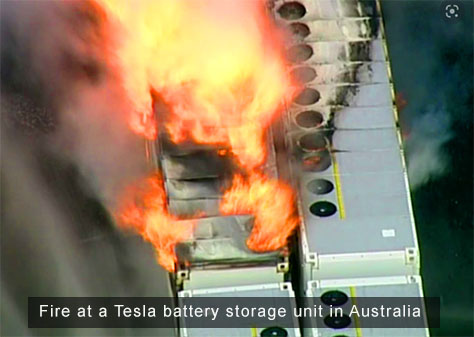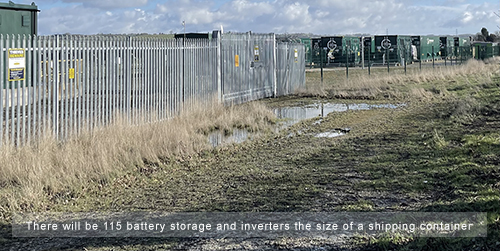Battery fire risks
There are to be 32 Lithium-ion (Li-ion) battery containers at Woolpots Solar Farm, which are concentrated together as a ‘Battery Energy Storage System’ (BESS) in the 4 - 5 acre sub-compound to be located by the road just south-east of Husthwaite.
Li-ion batteries are used in electric cars and also in phones, iPads etc. While generally stable, they present a major hazard if they over-heat which can happen for many reasons e.g. failure of a cooling system, a physical impact or even an inherent defect. The more cells in use, the higher the risk of a malfunction. And the consequences could be catastrophic.

If just one Li-ion battery cell overheats, it can start a process called ‘thermal runaway’ which results in the heat spreading very rapidly from cell to cell until the entire unit is burnt out. This process generates a mixture of toxic and flammable gases including Hydrogen Fluoride, Carbon Monoxide and Methane which can cause explosions. The resulting fire can be very intense with reports of 50-70 feet flames.
Strictly speaking, this is not a ‘fire’ in the normal sense as it requires no oxygen. It is an electro-chemical reaction. The reaction only stops once the cells are sufficiently cooled with the result that thermal runaway in a large Li-ion battery unit is uncontrollable except by the use of massive amounts of water e.g. 25,000 gallons of water were required to extinguish one Tesla car fire in 2020. There are no significant water sources within or close to the Woolpots sites.
Hydrogen Fluoride, which would be the gas usually produced in the greatest quantities, is toxic and sometimes lethal by inhalation and by skin contact. The prevailing wind around Husthwaite is westerly which means that any toxic gases would most often be blown towards the village with the primary school being one of the closest buildings to both sites. The huge volume of water used to cool a fire (estimated by independent experts at 5½ million litres over a 24 hour period) will also become contaminated with toxins (principally Hydrofluoric acid) risking further injury and long-lasting environmental damage in the subsoil and nearby watercourses.
While the chances of malfunction are small, they are not negligible and there have been an increasing number of BESS fires across the world in recent years, including in Liverpool in 2020 when a battery storage facility, much smaller than the one proposed at Woolpots, exploded for no apparent reason. Debris was blown over 100 feet away from the site and it took the emergency services 59 hours to bring the ‘fire’ under control. As a result, the UK National Fire Council Chiefs have updated Guidance on this issue and confirmed that it is up to the applicant to prove that the site can be operated safely and to provide all necessary information to the fire service. But fire safety is not adequately addressed in the application and only limited consultation has apparently taken place with the relevant emergency services.
Threat to aviation
‘Glint and Glare’ from the rows and rows of panels (could be an irritation for many residents of Husthwaite as the village sits above the site and it is not possible to screen the panels completely due to the hills. The panels will move during the day making this a continuous issue. Walkers, cyclists and horse-riders in the area will also be affected.
More importantly, Glint and Glare can be a very real problem for pilots of low level aircraft, particularly during landing and take-off and has been known to cause serious accidents. It is important to consider the long established air sports club at Baxby the private airfield at Providence Hill both nearby.
 Severe loss of amenity value for visitors – This is a very popular area for walkers, campers, cyclists, riders, birdwatchers etc. who will be put off during the intense (optimistically estimated) 6 - 8 month construction phase during which time the access roads will either be closed or being used by heavy transport, Some visitors may not return due to highly visible and prominent industrial sites alongside paths and roads.
Severe loss of amenity value for visitors – This is a very popular area for walkers, campers, cyclists, riders, birdwatchers etc. who will be put off during the intense (optimistically estimated) 6 - 8 month construction phase during which time the access roads will either be closed or being used by heavy transport, Some visitors may not return due to highly visible and prominent industrial sites alongside paths and roads.
Severe loss of amenity value for residents of both villages . TheHambleton Plan recognises that people choose to live in the area due to its rural peaceful setting - the installation will destroy that, resulting in depreciation of house prices and possibly also a long term decline in population. During the construction phase, it is estimated that a large lorry will pass down one or other access road every 20 minutes during working hours. Once the installation is operational, its huge size, high visibility and industrial nature will dominate the area and impact on local people’s enjoyment of their properties and their surroundings.
Damage to local economy - local businesses in the area, which rely on tourism, including the Plum and Partridge Pub, the Hideaway campsite, the Yorkshire Penny café, , the Alpaca farm, and various holiday lets, expect to lose revenue. This is totally contrary to Hambleton Plan which aims to ‘make the most of the area’s location and the associated opportunities for encouraging growth of the tourism economy’ and thus specifically requires any diversification proposals to be capable of ‘integration into the landscape’ .
Tourism
Severe loss of amenity value for visitors – This is a very popular area for walkers, campers, cyclists, riders, birdwatchers etc. who will be put off during the intense (optimistically estimated) 6 - 8 month construction phase during which time the access roads will either be closed or being used by heavy transport, Some visitors may not return due to highly visible and prominent industrial sites alongside paths and roads.
Severe loss of amenity value for residents of nearby villages. The Hambleton Plan recognises that people choose to live in the area due to its rural peaceful setting - the installation will destroy that, resulting in depreciation of house prices and possibly also a long term decline in population. During the construction phase, it is estimated that a large lorry will pass down the access road to Husthwaite every 20 minutes during working hours. Once the installation is operational, its huge size, high visibility and industrial nature will dominate the area and impact on local people’s enjoyment of their properties and their surroundings.
Damage to local economy - local businesses in the area, which rely on tourism, including the Plum and Partridge Pub, the Hideaway campsite, the Yorkshire Penny café, the Alpaca farm, and various holiday lets, expect to lose revenue. This is totally contrary to Hambleton Plan which aims to ‘make the most of the area’s location and the associated opportunities for encouraging growth of the tourism economy’ and thus specifically requires any diversification proposals to be capable of ‘integration into the landscape’.
Landscape Impact
 Woolpots is situated within 1 km of Husthwaite and the nearby Howardian Hills AONB; is within 5 km of the White Horse in the North York Moors National Park. It is on undulating land (contrary to NPPF). Due to the topography, it will be visible from other nearby villages and from the AONB/National Park - and this cannot be mitigated by planting. WS Woolpots will dominate the main access road to Husthwaite and be visible from the AONB and the National Park.
Woolpots is situated within 1 km of Husthwaite and the nearby Howardian Hills AONB; is within 5 km of the White Horse in the North York Moors National Park. It is on undulating land (contrary to NPPF). Due to the topography, it will be visible from other nearby villages and from the AONB/National Park - and this cannot be mitigated by planting. WS Woolpots will dominate the main access road to Husthwaite and be visible from the AONB and the National Park.
- An industrial landscape;
- Adjacent to the AONB;
- Built on 128 Acres of good agricultural land of which 70% is BMV (Best Most Versatile)
- Concentrated high-density massing clustered in a rural landscape.
- A stark contrast to the agricultural and rural nature of our distinctive rural landscape.
- Mostly on rising and undulating land.
- Visible from 12 miles away.
- Planted screening would take years to have any effect.
- Together with the existing Peterhill and Boscar solar farms (243 acres combined), this will result in 370 acres of solar panels which would currently be one of the largest operational farms in UK.
